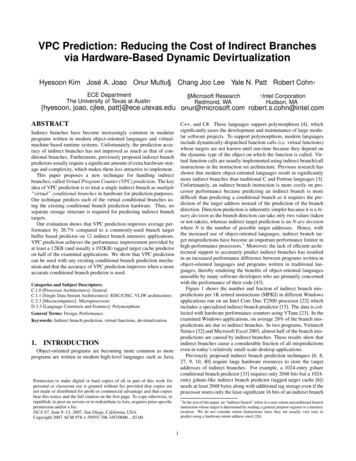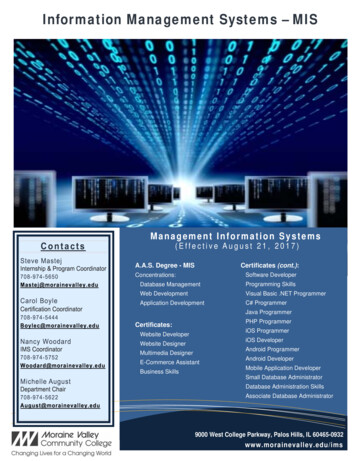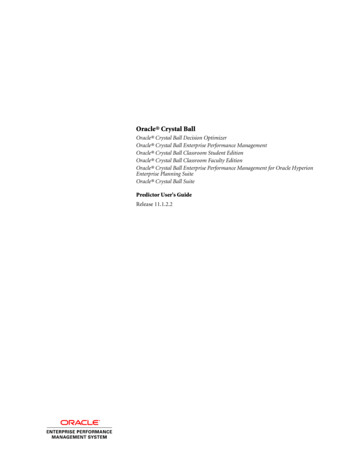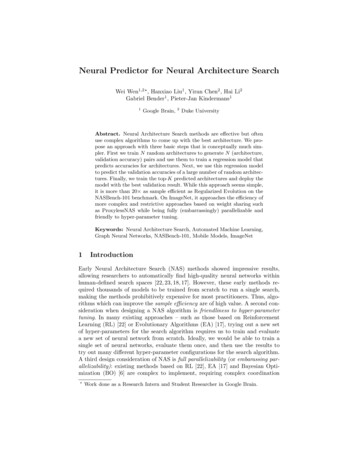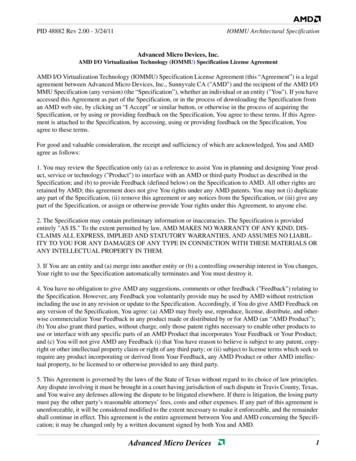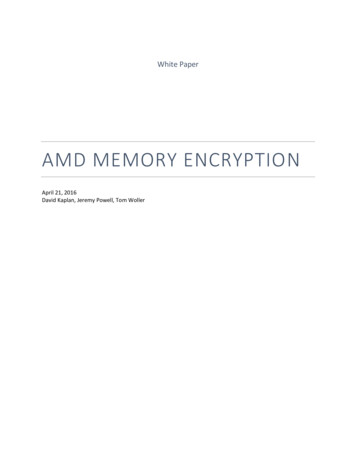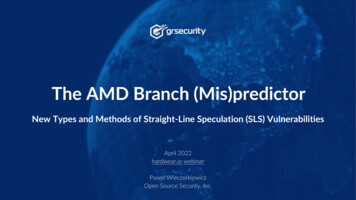
Transcription
The AMD Branch (Mis)predictorNew Types and Methods of Straight-Line Speculation (SLS) VulnerabilitiesApril 2022hardwear.io webinarPawel WieczorkiewiczOpen Source Security, Inc.
whoami Pawel Wieczorkiewicz Email: wipawel@grsecurity.net Twitter: @wipawelSecurity Researcher at Open Source Security, Inc. (creators of grsecurity ) Low-level security research of system software and hardware Reverse engineering and binary analysisKernel Test Framework (KTF) creator and maintainer https://github.com/KernelTestFramework/ktf
Outline Theory Quick AMD microarchitecture overview Branch predictors Practice CVE-2021-26341: a new unexpected type of SLS Basic introduction Basic introduction Speculation window and its limitations Purpose SLS gadgets Building blocks and functionality Store-to-Load Forwarding (STLF) Different types of branches branchesStraight-Line Speculation (SLS) Basic introduction Root cause mechanics TypesSpectre v1: Fall-thru speculation of conditional Bounds check latency related out-of-boundarray access? Branch predictor involvement Speculation window and its limitationsSLS mitigations
Microarchitecture - overview AMD Zen2 microarchitecturesource: en.wikichip.org
Microarchitecture - overview AMD Zen2 microarchitecture Frontendsource: en.wikichip.org
Microarchitecture - overview AMD Zen2 microarchitecture Frontend Fetchsource: en.wikichip.org
Microarchitecture - overview AMD Zen2 microarchitecture Frontend Fetch Decodesource: en.wikichip.org
Microarchitecture - overview AMD Zen2 microarchitecture Frontend Fetch Decode Dispatchsource: en.wikichip.org
Microarchitecture - overview AMD Zen2 microarchitecture Backendsource: en.wikichip.org
Microarchitecture - overview AMD Zen2 microarchitecture Backend Superscalarsource: en.wikichip.org
Microarchitecture - overview AMD Zen2 microarchitecture Backend Superscalar Out-of-order executionsource: en.wikichip.org
Microarchitecture - overview AMD Zen2 microarchitecture Backend Superscalar Out-of-order execution In-order retiresource: en.wikichip.org
Microarchitecture - overview AMD Zen2 microarchitecture Frontend Fetch Decode DispatchFrontendBackend Superscalar Out-of-order execution In-order retireBackendsource: en.wikichip.org
Microarchitecture - overview AMD Zen2 microarchitecture Frontend Fetch Decode DispatchFrontendBackend Superscalar Out-of-order execution In-order retireBackendsource: en.wikichip.org
Microarchitecture - overview AMD Zen2 microarchitecture Frontend Fetch Decode DispatchFrontendBackend Superscalar Out-of-order execution In-order retireBackendsource: en.wikichip.org
Branch predictors - purpose Why do we need the branch prediction unit (BPU)? Backend of modern superscalar and out-of-order CPUs can have many instructions “in-flight” Frontend must keep up supplying instructions to the Backend Any feedback from Backend to Frontend will stall the CPU Must be avoided Some definitive information available only in the Backend Frontend must predict the likely outcome upfront Correct prediction performance win Misprediction penalty, Frontend re-steer when Backend detects The better (more accurate) prediction rate, the better performance (fewer bubbles)Frontend needs to know where to find next instructions to fetch and decode Easy for sequential execution next instruction Problematic upon control flow change (branch) Two questions: IF – taken or not taken Where-to – address of the next instruction
Branch predictors - design and building blocks Branch Prediction Unit (BPU) Many different designs and categories Static vs Dynamic One-Level vs Two-level Local vs Global Adaptive Agree Hybrid Neural (Machine Learning) Perceptron-based (AMD Zen2)
Branch predictors - design and building blocks Branch Prediction Unit (BPU) Prediction based on the actual branch instruction anda pre-defined heuristic:Many different designs and categories Type of branch Static vs Dynamic One-Level vs Two-level Conditional Local vs Global Unconditional Adaptive Agree Hybrid Neural (Machine Learning) Perceptron-based (AMD Zen2) Branch direction Forward BackwardExamples: Unconditional branches are always taken Backward branches taken (loops accuracy) Forward branches not takenUnconditional branches are easier to predict than conditional
Branch predictors - design and building blocks Branch Prediction Unit (BPU) Many different designs and categories Static vs Dynamic One-Level vs Two-level Local vs Global Adaptive Agree Hybrid Neural (Machine Learning) Perceptron-based (AMD Zen2) Prediction based on previous execution results of agiven branch If taken before, likely to be taken again
Branch predictors - design and building blocks Branch Prediction Unit (BPU) Many different designs and categories Static vs Dynamic One-Level vs Two-level Local vs Global Adaptive Agree Hybrid Neural (Machine Learning) Perceptron-based (AMD Zen2) Prediction based on previous executions results of agiven branch If taken before, likely to be taken again 1-bit saturation counter Previously taken or not taken
Branch predictors - design and building blocks Branch Prediction Unit (BPU) Many different designs and categories Static vs Dynamic One-Level vs Two-level Local vs Global Adaptive Agree Hybrid Neural (Machine Learning) Perceptron-based (AMD Zen2) Prediction based on previous executions results of agiven branch If taken before, likely to be taken again 1-bit saturation counter Previously taken or not taken2-bit saturation counter Four states state machine
Branch predictors - design and building blocks Branch Prediction Unit (BPU) Many different designs and categories Static vs Dynamic One-Level vs Two-level Local vs Global Adaptive Agree Hybrid Neural (Machine Learning) Perceptron-based (AMD Zen2) Prediction is based on a two-dimensional table of 2bit saturation counters (Branch/Pattern HistoryTable) indexed with branch history register
Branch predictors - design and building blocks Branch Prediction Unit (BPU) Many different designs and categories Static vs Dynamic One-Level vs Two-level Local vs Global Adaptive Agree Hybrid Neural (Machine Learning) Perceptron-based (AMD Zen2) Branch History Table is indexed using a distinctbranch history register for each encounteredconditional branch
Branch predictors - design and building blocks Branch Prediction Unit (BPU) Many different designs and categoriesBranch History Table is indexed using a distinctbranch history register for each encountered Static vs Dynamic One-Level vs Two-level Local vs Global(global) branch history register for all encountered Adaptiveconditional branches Agree Hybrid Neural (Machine Learning) Perceptron-based (AMD Zen2)conditional branch Branch History Table is indexed using a shared Correlation between different branches isconsidered May harm prediction accuracy when too manybranches are not correlated
Branch predictors - design and building blocks Branch Prediction Unit (BPU) Many different designs and categories gshare – Two-level adaptive predictor with globalhistory bufferStatic vs DynamicProgram Counter One-Level vs Two-level Local vs Global Adaptive Agree Hybrid Neural (Machine Learning) Branch History Table (BHT)STWTWNTSNTSTWTWNTSNTSTWTWNTSNTBranch Direction PredictionTaken / Not TakenPerceptron-based (AMD Zen2)STWTWNTSNTSTWTWNTSNTGlobal History Register (GHR)TTNTNNTNTN
Branch predictors - design and building blocks Branch Prediction Unit (BPU) Many different designs and categories Static vs Dynamic One-Level vs Two-level Local vs Global Adaptive Agree Hybrid Neural (Machine Learning) Perceptron-based (AMD Zen2)Consists of multiple different branch predictionmechanisms Prediction is based on: Prediction mechanism that has had highestaccuracy in the past Combined output of all implementedprediction mechanisms
Branch predictors - design and building blocks So far, we have been implicitly focusing on direct conditional branch predictions Taken / Not taken Question: IF at all
Branch predictors - design and building blocks So far, we have been implicitly focusing on direct conditional branch predictions Taken / Not taken Question: IF at allWhat about other branch types? Do they need a branch predictor too?
Branch predictors - design and building blocks So far, we have been implicitly focusing on direct conditional branch predictions Taken / Not taken Question: IF at allWhat about other branch types? Do they need a branch predictor too? Yes, they do! Question: Where-to
Branch predictors - design and building blocksBranch Target Buffer (BTB) So far, we have been implicitly focusing ondirect conditional branch predictions Taken / Not taken Question: IF branch at allBranch Target Address 1Branch Target Address 2Branch Target Address 3.What about other branch types? Do they need a branch predictor too? Yes, they do! Question: Where-toAnother important BPU component: Branch Target Buffer (BTB)Branch Target Address NTarget Address Prediction
Branch predictors – branch target bufferBranch Target Buffer (BTB) Predicts address of next instructions after the controlflow changes because of a branch Branch Target Address 1Branch Target Address 2Branch Target Address 3.Turns out: ALL branch types need BTB! Frontend fetches and decodes, but does notexecute instructions Frontend needs to know where to fetch nextinstructions from upon a branch It must not wait for Backend Performance!Hence, BPU is a Frontend’s component andleverages BTB to steer Frontend upon branchesBranch Target Address NTarget Address Prediction
Branch predictors – branch target bufferBranch Target Buffer (BTB) Analyzing branch instructions addressing is backend’s job Where-To problem: Direct conditional branches: Not taken next instruction backward, forward, not easyDirect unconditional branches: Always taken where? easyTaken where-to? Branch Target Address 1Branch Target Address 2Branch Target Address 3.backward, forward, not easyIndirect unconditional branches: Always taken where? backward, forward, not easyBranch Target Address NTarget address may change at runtime, not static static prediction will not do BTB is crucial for performanceTarget Address Prediction
Hybrid branch predictor – example
Hybrid branch predictor – building blocksAnswer: IF
Hybrid branch predictor – building blocksAnswer: Where-to
Branch predictors – different types of branches Direct Conditional Jumps Taken Not TakenUnconditional Jumps CallsIndirect Unconditional Jumps Calls Function return
Branch predictors – different types of branches Direct Conditional x86: Jcc address Jumps Taken Not TakenUnconditional Jumps CallsControl flow change to the specified address,when condition is met Condition cc is based on the state of the statusflags (EFLAGS register) Indirect JA – jump if aboveJB – jump if below Unconditional Jumps Calls Function return Status flags: CF 1JE – jump if equal Status flags: CF 0 and ZF 0Status flags: ZF 1JNE – jump if not equal Status flags: ZF 0
Branch predictors – different types of branches Direct Conditional Jumps Taken Not TakenUnconditional Jumps CallsExample (Taken)a 0if (a 0)*addr %raxelse%rax *addrIndirect Unconditional Jumps Calls Function returnxor %rdi, %rdi ; set ZF 1test %rdi, %rdi ; set ZF 1je END LABEL ; if ZF 1 goto END LABELmov (%rsi), %rax ; memory loadEND LABEL:mov %rax, (%rsi) ; memory store
Branch predictors – different types of branches Direct Conditional Jumps Taken Not TakenUnconditional Jumps CallsExample (Not Taken)a 1if (a 0)*addr %raxelse%rax *addrIndirect Unconditional Jumps Calls Function returnmov 1, %rditest %rdi, %rdi ; set ZF 0je END LABEL ; if ZF 1 goto END LABELmov (%rsi), %rax ; memory loadEND LABEL:mov %rax, (%rsi) ; memory store
Branch predictors – different types of branches Direct Conditional Jumps Taken Not Takenx86: JMP address specified address, without return Direct – target address static UnconditionalPart of the instructionUsed by compilers to implement: Loops Jumps Tail calls Calls Sharing common code blocks Indirect Unconditional control flow change to theUnconditional Jumps Calls Function return Error handling code Other uses: RAP – jumping over meta-data in code Live patching
Branch predictors – different types of branches Direct Conditional Jumps Taken Not TakenUnconditional Jumps Callsx86: CALL address address with return Jumps Calls Function returnPart of the instruction CALL instruction push %rip; jmp address Execution flow is expected to resume at the CALLfollowing instruction eventually Unconditional Direct – target address static Indirect Unconditional control flow change to the specified Used by compilers to implement: Procedure calls Recursive calls Other uses: x86.get pc thunk.* – position independentcode execution helper on i386/i686
Branch predictors – different types of branches Direct Conditional Taken Not TakenUnconditional control flow change to the dynamicaddress specified via register or memoryJumpsdereference, without return UnconditionalIndirect – target address dynamic May change at runtime Specified by register or memory location Jumps i386: absolute address Calls x64: pc-relative offset Indirect x86: JMP reg (or [mem])Unconditional Jumps Calls Function returnUsed by compilers to implement: Tail calls Jump tables Switch-case Virtual function tables (C ) Multiway conditional branches
Branch predictors – different types of branches Direct Conditional x86: CALL reg (or [mem]) Jumps Taken Not Takendynamic address specified via register ormemory dereference, with return Unconditional Jumps CallsUnconditional control flow change to theIndirect – target address dynamic May change at runtime Specified by register or memory locationIndirect Unconditional i386: absolute address x64: pc-relative offsetUsed by compilers to implement: Jumps Function pointers Calls Virtual functions (C ) Function return Position independent code
Branch predictors – different types of branches Direct Conditional x86: RET Jumps Taken Not Taken address located on stack Unconditional Jumps Calls Indirect Unconditional Jumps Calls Function returnUnconditional control flow change to the Indirect – target address dynamic May change at runtime Stored on stack upon function callUsed by compilers to implement: Function returns RetpolineDoes not use BTB, but Return Stack Buffer(RSB) aka Return Address Stack (RAS)
Straight-Line Speculation (SLS) Straight-Line Speculation term was coined by Arm result of Google SafeSide project research - CVE-2020-13844 Arm described SLS as a speculative execution past an unconditional change in the control flow:"Straight-line speculation would involve the processor speculatively executing the nextinstructions linearly in memory past the unconditional change in control flow“ Shortly after, the SLS was also observed on “some x86 CPUs” Initially observed on indirect unconditional branches on Arm CPUsAlso, on indirect unconditional branchesHowever: SLS had to have been observed on x86 CPUs prior to Arm coining the term Appearance of traps after RET instructions: 2018: Microsoft Windows 2019: grsecurity
Straight-Line Speculation (SLS) Types of SLS Indirect Unconditional Jump and Call JMP/CALL reg JMP/CALL [mem]Function return RET
Straight-Line Speculation (SLS) Types of SLS Indirect Unconditional Jump and Call JMP/CALL reg JMP/CALL [mem]Function return RETWhat about direct branches?
CVE-2021-26341 - Direct unconditional branch SLS AMD x86 CPUs (Zen1 and Zen2 microarchitectures) All direct unconditional branch instructions experience SLS vulnerability too! JMP address CALL addressBranch direction does not matter Forward and backward branches suffer from the SLSIt is possible to trigger the SLS between two co-located hyper-threadsAMD x86 CPU (Zen3 microarchitecture) SLS on direct unconditional branches seems to be fixed Big design upgrade of the branch predictor unit Intentional or accidental?
CVE-2021-26341 - Direct unconditional branch SLS SLS code example; memory address 0 whose access latency allows to observe the speculative execution0. mov CACHE LINE 0 ADDR, %rsi; memory address 1 whose access latency allows to observe the speculative execution1. mov CACHE LINE 1 ADDR, %rbx; flush both cache lines out of cache hierarchy to get a clean state2. clflush (%rsi)3. clflush (%rbx)4. mfence5. jmp END LABEL; memory load to the flushed cache line; it never executes architecturally6. mov (%rsi / %rbx), %rax7. END LABEL:8. measure CACHE LINE 0/1 ADDR access time
Straight-Line Speculation (SLS) Why would a modern CPU speculate past a direct unconditional branch? After all: Its target address is static! And encoded as part of the instruction!There is no latency involved Its unconditional – no need to evaluate conditions
Straight-Line Speculation (SLS) Why would a modern CPU speculate past a direct unconditional branch? After all: Its target address is static! There is no latency involved And encoded as part of the instruction!Let’s see why Its unconditional – no need to evaluate conditions
Straight-Line Speculation (SLS) - mechanics
Straight-Line Speculation (SLS) - mechanicsBranch
Straight-Line Speculation (SLS) - mechanicsBranch Target BufferBranch
Straight-Line Speculation (SLS) - mechanicsJump target addressPredicted correctly
Straight-Line Speculation (SLS) - mechanicsMispredicted
Straight-Line Speculation (SLS) - mechanics
Straight-Line Speculation (SLS) - mechanics
Straight-Line Speculation (SLS) - mechanics
Straight-Line Speculation (SLS) - mechanics
CVE-2021-26341 - Direct unconditional branch SLS If there is no entry in the BTB (or Return Address Stack (RAS) for RET instructions) the branch will be mispredicted and SLS might occur What does it mean? Any branch type!we can easily and almost 100% reliably make affected AMD CPUs mispredict any branch Direct or indirect Conditional or unconditional and trigger SLS past it.How? We need to make sure the corresponding BTB entry is not present Simplest way: flushing entire BTB
CVE-2021-26341 - Direct unconditional branch SLS Flushing entire BTB Execute a large enough number of the consecutive branches Each will take at least one entry in the BTB BTB entries can hold up to two branches within the same 64byte instruction block Provided the first branch is a conditional branchSolution Place two unconditional branches within a single cache-line Upon execution at least one entry of the BTB will betaken Repeat this code construct a NUMBER of times Entire BTB overwritten if the NUMBER is equal to orgreater than the number of entries of the given BTB.macro flush btb NUMBER; start at a cache-line size aligned address.align 64; repeat the code between .rept and .endr; directives a NUMBER of times.rept \NUMBERjmp 1f; first unconditional jump.rept 30 ; half-cache-line-size paddingnop.endr1:jmp 2f; second unconditional jump.rept 29 ; full cache-line-size paddingnop.endr2:nop.endr.endm
CVE-2021-26341 - Direct unconditional branch SLS Speculation window up to 8 simple and short (up to 16 bytes) x86 instructions can be speculatively executed in practice: 4-5 short x86 instructions that do not compete for execution unitsup to 2 memory loads can be executed speculatively the loads (even pre-cached) cannot provide data to the following uops in time the loads do get scheduled and can leave traces in cache hierarchyLimitations constructing a full Spectre v1 gadget is not possible with this type of SLS Secret data needs to be available in GPR (registers) for the SLS gadget or
CVE-2021-26341 - Direct unconditional branch SLS Store-To-Load-Forwarding (STLF) Forwarding data of a completed (but not yet retired) stores to the later loads Stores are buffered in the Store Queue (WAW and WAR dependencies) Later loads must get fresh data either from the Store Queue (if fresh) or memoryMemory loads executed under SLS receive data from the earlier stores to the same address STLF enables speculative loads under SLS to execute fast Such loads do provide data to their dependent uopsSTLF requirements Earlier store contains all the load’s bytes (cannot load more) CPU uses address bits 11:0 to determine STLF eligibility Same address space and ideally same registers, closely grouped together
CVE-2021-26341 - Direct unconditional branch SLS SLS gadget exampleasm goto ("mov 0x4141414141414141, %%rbx\n“"mov %%rbx, (%0)\n“"sfence\n“"lfence\n“".align 64\n“"jmp %l[end]\n“"mov (%0), %%rbx\n“"and %1, %%rbx\n“"add %2, %%rbx\n“"mov (%%rbx), %%ebx\n“:: "r" (&path), "r" (1UL bufsiz), "r" (buf): "rbx", "memory“: end);end:
Straight-Line Speculation (SLS) Types of SLS Indirect Unconditional Jump and Call JMP/CALL reg JMP/CALL [mem]Function return RETDirect Unconditional Jump and Call JMP/CALL address
Straight-Line Speculation (SLS) Types of SLS Indirect Unconditional Jump and Call JMP/CALL reg JMP/CALL [mem]Function return RETDirect Unconditional Jump and Call JMP/CALL addressWhat about direct conditional branches?
Speculation of conditional branches Both paths of conditional branches (taken or not taken) are architecturally legitimate Hence, there is no direct conditional branch SLS Rather, we speak of a branch fall-through speculationIf a conditional branch is architecturally taken It could be speculatively executed as not taken mispredictedTypical Spectre v1 situation
Spectre v1: a fall-thru speculation of conditional branches Spectre v1 and conditional branches relation A common Spectre v1 gadget Out-of-bound array access Speculative bypass of a bound check Bound check memory access latency Most speculation blocking mitigation target “array-based” Spectre v1 gadgets But, is Spectre v1 really limited to that?
Spectre v1: a fall-thru speculation of conditional branches Flush BTB to trigger a fall-thru speculation for a conditional branch No condition evaluation considerations necessary No memory access (or any other) latency required Easy to make any conditional branch mispredict Even a trivial oneSpeculative type confusion No need for array out-of-bound Works also on AMD Zen3! Neither this nor direct unconditional branch SLS affects Intel
Spectre v1: a fall-thru speculation of conditional branches Gadget example; memory address whose access latency allows to observe the mispredictions0. mov CACHE LINE ADDR, %rsi; flush the cache line out of cache hierarchy to get a clean state1. clflush (%rsi)2. mfence3. xor %rdi, %rdi ; set ZF 14. jz END LABEL; if ZF 1 goto END LABEL; memory load to the flushed cache line; it never executes architecturally5. mov (%rsi), %rax6. END LABEL:7. measure CACHE LINE ADDR access time
Spectre v1: a fall-thru speculation of conditional branches Speculation window Noticeably shorter than “regular” Spectre v1 speculation window up to 8 simple and short (up to 16 bytes) x86 instructions can be speculatively executedin practice: 5-7 short x86 instructions that do not compete for execution units up to 2 memory loads can be executed speculativelythe loads (must be pre-cached) do provide data to the following uops in time Constructing a full Spectre v1 gadget is possible Secret data can be anywhere in memory Limitations Shorter speculation window fewer instructions More difficult to build cache oracle
SLS Mitigations Here we discuss SLS mitigation for the following branches: Direct unconditional jump Indirect unconditional jump Function return RETThese three cases are easy to mitigate Just put a speculative execution barrier (i.e., serializing or ordering instruction) after The shorter the instruction the better Never gets executed architecturallySLS mitigation for direct and indirect unconditional call is not that simple At some point control flow resumes execution at an instruction following the call The speculative execution barrier gets executed architecturally Must not have architectural “side-effects”
SLS Mitigations Mitigation for Direct unconditional jump Indirect unconditional jump Function return RETINT3 – single byte opcode (0xCC)
SLS Mitigations
SLS Mitigations
SLS Mitigations
SLS Mitigations
SLS Mitigations
SLS Mitigations
SLS Mitigations
SLS Mitigations Mitigation for Direct unconditional call Indirect unconditional callLFENCE - Not good for performance!XOR EAX, EAX – complicated!
SLS Mitigations Mitigation for Direct unconditional call Indirect unconditional call XOR EAX, EAX Based on compiler post-call behaviorassumptionsLFENCE - Not good for performance! XOR EAX, EAX – complicated!Callee-clobbered registers won’t be usedwithout re-write Callee-preserved registers are preserved– invariant Only return value register (eax) might beabused Clearing return value register before the call Forces eax value to 0 during SLS No arbitrary content of eax
SLS Mitigations Mitigation for Direct unconditional call Indirect unconditional call XOR EAX, EAX Complicated: Based on compiler assumptions thatLFENCE - Not good for performance!might not always holdXOR EAX, EAX – complicated! Compiler implementation dependentSome calling convention ABIs use eax asfunction input parameter Fastcall / regparm(3)Variadic functions may use eax asparameter Small structures returned via eax edx What to do with: CALL eax
Thank youBlogs:https://grsecurity.net/amd branch mispredictor just set it and forget ithttps://grsecurity.net/amd branch mispredictor part 2 where no cpu has gone beforewipawel@grsecurity.netGrsecurity is created by
The AMD Branch (Mis)predictor New Types and Methods of Straight-Line Speculation (SLS) Vulnerabilities April 2022 hardwear.io webinar Pawel Wieczorkiewicz Open Source Security, Inc. Pawel Wieczorkiewicz Email: wipawel@grsecurity.net Twitter: @wipawel





